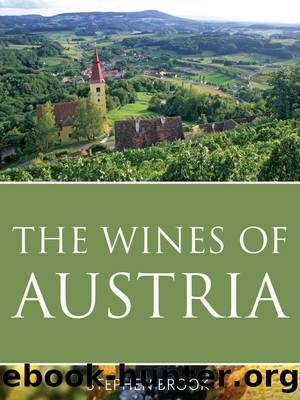The Wines of Austria by Brook Stephen

Author:Brook, Stephen
Language: eng
Format: epub
Publisher: Infinite Ideas Limited
Published: 2015-10-26T00:00:00+00:00
9
THERMENREGION
With 2290 hectares under vine, the Thermenregion is really two separate regions that were yoked together in 1986. It lies close to the capital: the towers of Vienna are clearly visible to the north from the highest vineyards. The northern part was always one of Austriaâs most renowned wine regions and took its name from the principal village, Gumpoldskirchen; it also embraces other villages such as Traiskirchen, Perchtoldsdorf, and Pfaffstaetten. Just south of here are the spa towns of Baden and Bad Vöslau, which give the region its name. Between here and the town of Wiener Neustadt is a flatter and more dispersed region, with the most important wines being produced around Tattendorf, which has acquired a reputation for fine red wines, notably from St Laurent. The gravelly plains of Tattendorf and the slopes around Gumpoldskirchen really have very little in common.
As in many other Austrian wine regions, there is evidence that both the Celts and then the Romans planted vines and made wines here. When monks from Citeaux came to the Vienna area to found the Cistercian abbey of Heiligenkreutz, it is believed that they brought some Burgundian wine varieties with them. These varieties thrived alongside local grapes such as Rotgipfler and Zierfandler, which were particularly well suited to the production of opulent sweet wines. In the eighteenth and nineteenth centuries the Gumpoldskirchner wines enjoyed an international reputation as high as those from Rust and Tokaj, and its vineyards benefitted from imperial protection. It was customary to blend Rotgipfler and Zierfandler, probably because they grew together as field blends, and because growers rarely identified the varieties on the label, calling the wines simply Gumpoldskirchner. From the 1990s there was a growing tendency to produce each variety on its own.
However, the Gumpoldskirchen region was prized long before that. The combination of well-drained slopes, the warmth of the Pannonian climate, and good ventilation made this area ideal for viticulture. The former prosperity of the village is evident from the profusion of sixteenth-century mansions and wineries, and the grandeur of the Rathaus. The major Austrian monasteries â Klosterneuburg, Melk, Krems, Heiligenkreutz â all had extensive vineyards here, and most still do, although they tend to be leased to local growers. Thus the former Melk vineyards are now leased to Reinisch.
Local grower Harald Zierer claims that until the 1950s the wines from Gumpoldskirchen were essentially dry. Not everyone agrees. Hannes Reinisch argues that it was rare for yeasts to succeed in fermenting the wines, especially in ripe years, to full dryness; nor was there much use at that time of sulphur dioxide to arrest fermentation. From the late 1950s the grapes gradually but steadily increased in residual sugar, in response to demand from German as well as Austrian consumers. This was a common trend across Europe, as sugar was scarce and consumers valued the nutritional as well as gustatory character of sweet wines. This demand enriched the local growers and perhaps blinded them to the dangers that came with it. By the 1980s more wine from Gumpoldskirchen was being exported than could possibly be produced.
Download
This site does not store any files on its server. We only index and link to content provided by other sites. Please contact the content providers to delete copyright contents if any and email us, we'll remove relevant links or contents immediately.
A Court of Wings and Ruin by Sarah J. Maas(7569)
The Sprouting Book by Ann Wigmore(3516)
Better Homes and Gardens New Cookbook by Better Homes & Gardens(3496)
The Death of the Heart by Elizabeth Bowen(3492)
BraveTart by Stella Parks(3373)
Salt, Fat, Acid, Heat: Mastering the Elements of Good Cooking by Nosrat Samin(3086)
Sauces by James Peterson(3023)
The Bread Bible by Rose Levy Beranbaum(2977)
Kitchen confidential by Anthony Bourdain(2974)
Classic by Mary Berry(2921)
Solo Food by Janneke Vreugdenhil(2904)
Ottolenghi - The Cookbook by Yotam Ottolenghi(2811)
Martha Stewart's Baking Handbook by Martha Stewart(2754)
Day by Elie Wiesel(2695)
Betty Crocker's Good and Easy Cook Book by Betty Crocker(2663)
The Plant Paradox by Dr. Steven R. Gundry M.D(2518)
My Pantry by Alice Waters(2516)
The Kitchen Counter Cooking School by Kathleen Flinn(2462)
Hot Sauce Nation by Denver Nicks(2429)
